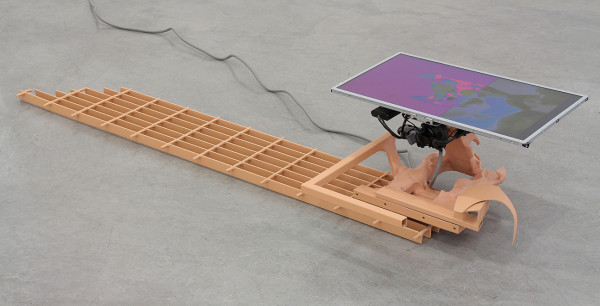Nate Boyce
Sunday, 22 December 2013
Work from his oeuvre
“With only thirty years under his belt, the San Francisco based Nate Boyce balances an artistic practice that jumps between international museum tours of his experimental music and video art performances and a studio practice that forces video into conversation with traditional sculpture.
When video art emerged in the 60’s, it became increasingly interested in exploring the possibilities and tricks of the medium and quickly fell out of step with the formal aesthetic questioning that characterized painting and sculpture of the same period. Though fluent in the language of technology, Boyce brings these formal investigations back to the forefront of his work.
Taking a small hand-carved and airbrushed object as his starting point, Boyce uses an obsolete low-resolution digital camera to capture video of the form slowing rotating. Using cutting-edge computer modeling, Boyce layers a slick undulating surface on the grainy image of the sculpture as it turns. The contrast between the visible grain of the original video and the clean texture of the CGI draws attention to the surface of the screen, evoking the critical history of painting rather than the more narrative tradition associated with film and video.
By its nature, video art disrupts our sense of space, as three-dimensional objects are depicted on a flat two-dimensional screen. Boyce confounds the tension between the two and three dimensional in his work by displaying video of a three-dimensional object on a two-dimensional LCD screen suspended within a three-dimensional sculptural pedestal. Early iterations of his sculptures played with the positive verses negative space of the pedestal, by creating a line drawing version of a traditional pedestal in welded-steel. Powder-coating the steel structure in the same pearlescent color as the rotating subject of the video reinforces the feedback-loop between the object and its support.
Recently, the structure of the pedestals have become more sculptural in form. In “Plinth Inhibitor” at the Bemis Center for Contemporary Art, the armature supporting the screens took an almost reclining form, spreading out across the floor and reorienting the screen upward to be viewed from above. In deliberately confusing the relationship between the sculpture and its pedestal, Boyce revisits the issues that fueled modernist sculpture.
Boyce’s facility with technology allows him to re-envision the ubiquitous modernist public sculpture by again subverting the traditional pedestal support. Rather than utilizing a white rectangular form meant to recede into the background, Boyce situated a recent sculpture on an irregularly shaped plinth that he airbrushed with a generic scene of a public park. Wrapping the surface of the three-dimensional pedestal with a two-dimensional image meant to evoke a three-dimensional park scene again disrupts our experience of space. This image-skin alludes to the way in which three-dimensional worlds are created in computer imaging, linking the sculptural support with his video work.
In a moment when technological obsolescence speeds ever forward, it is unique to find an artist who embraces outdated equipment and sets it in conversation with newer, shinier, cutting-edge technologies. Firmly rooted in the formal and aesthetic concerns of modernist sculpture, Boyce embraces the spectrum of technological means available to depict and manipulate the object in space. As these technologies continue to develop, it will be interesting to watch this multi-pronged practice evolve.”
text via SFAQ




